NIL
Nikki Spetseris previews ‘Full Court Press’ season two
Last year’s Full Court Press women’s NCAA basketball docuseries proved to be a remarkable moment. The series, from Omaha Productions, Words + Pictures, and ESPN, followed Caitlin Clark, Kamilla Cardoso, and Kiki Rice through a wild season that saw massive interest in them, especially around Clark breaking the NCAA scoring record. So how do you […]
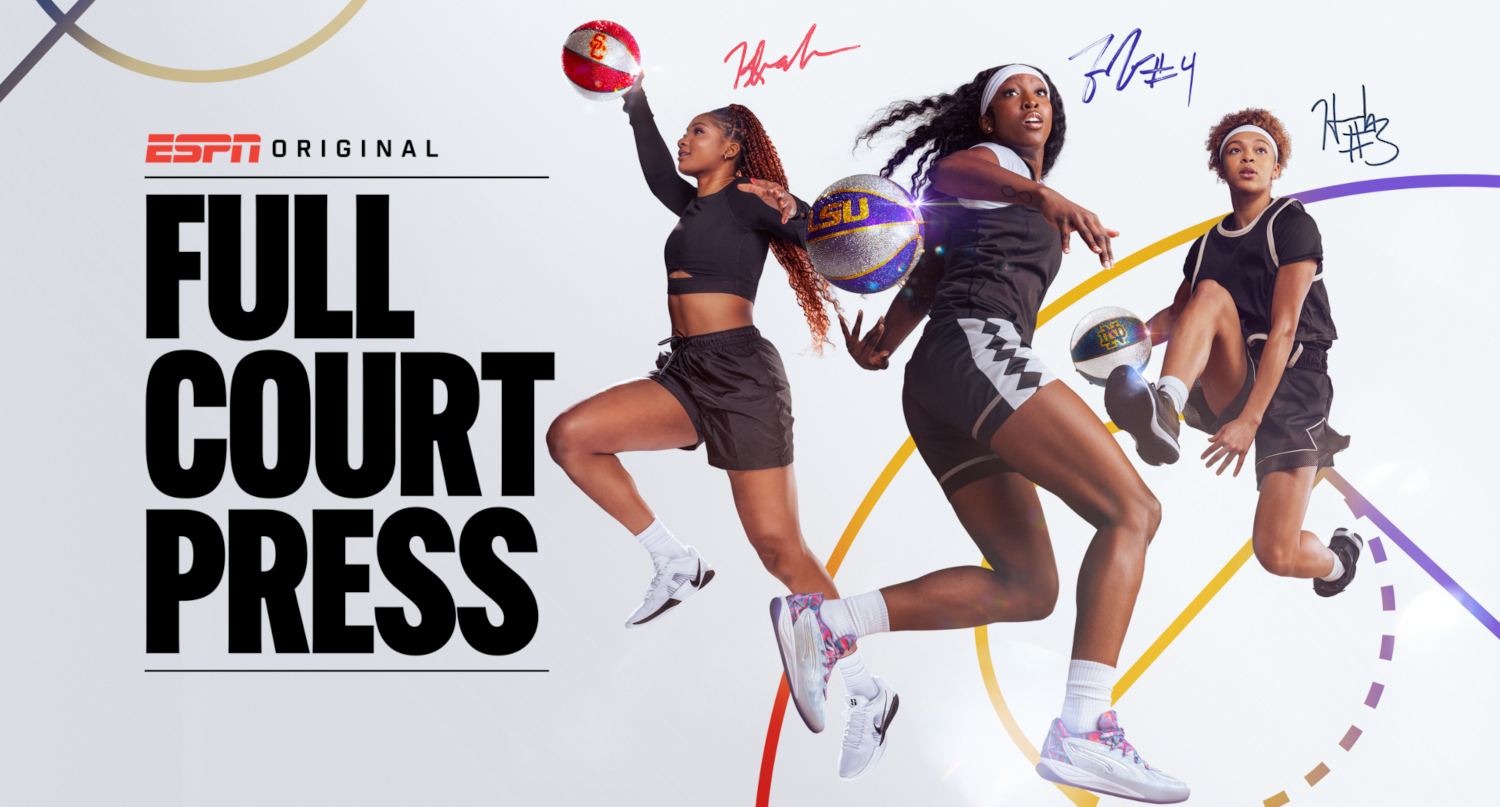
Last year’s Full Court Press women’s NCAA basketball docuseries proved to be a remarkable moment. The series, from Omaha Productions, Words + Pictures, and ESPN, followed Caitlin Clark, Kamilla Cardoso, and Kiki Rice through a wild season that saw massive interest in them, especially around Clark breaking the NCAA scoring record.
So how do you follow that up?
That was a key question around the second season of Full Court Press, which was green-lit last May. The first season drew a lot of attention, but there was discussion of how much of that was the Clark effect. And that fit into wider discussions about where women’s college basketball ratings would go post-Clark. Indeed, season one director Kristen Lappas even told Awful Announcing last spring “We caught lightning in a bottle” in terms of how well things broke for the first season of the show.
But the post-Clark era has seen ratings interest in women’s college basketball continue, with even some year-over-year growth. And that’s promising for the second season of Full Court Press, which premieres Saturday. Its first two episodes will air at 1 p.m. and 2 p.m. ET on ESPN, with the final two airing May 11 at 9 p.m. and 10 p.m. ET on ESPN2, and with all episodes available on ESPN+ following their airing.
Nikki Spetseris, who directed the second season of Full Court Press, spoke to AA on that this week. She said there were some questions on how to follow up the first season, but this one (covering Notre Dame sophomore guard Hannah Hidalgo, LSU junior guard Flau’jae Johnson and USC graduate student forward Kiki Iriafen) came together to provide its own unique set of stories.
“I think last season was amazing, but obviously they had a superstar, and a tangible thing to follow, which was her record-breaking season,” Spetseris said. “No one knew what to expect this season: will we live up to the hype of of the first one? And I think it’s almost more exciting, because we have…I don’t want to say they didn’t have three big personalities, but I do think that every woman got the same airtime [in S2], and we got to put a spotlight on three different personalities, programs, backgrounds, equally, and follow those stories.”
Telling three unique athletes’ stories
Each of those athletes has quite a different story. Spetseris said Johnson’s is a combination of her playing success, her business success, and her personal background.
“Flau’jae Johnson, the first time I met her in person, she just walked into the room, and there was this air about her. You’re like ‘She is a superstar.’ She just has that energy and that feeling around her. Not only are these three women amazing athletes, and we were able to see that, the discipline and the work they put in every day, but I think with Flau’jae, it’s the story off the court.
“I think her backstory is so inspiring, growing up with a single mom and her dad passed away while her mom was still pregnant with her. And she’s then pursuing his kind of rap career. I think she stands out with her off-the-court story. Also, she has more NIL deals than almost any college basketball player. So that was kind of interesting to follow, just a business mogul, musician, and athlete.”
With Hidalgo, Spetseris said the docuseries shows off a side of her that fans might not expect.
“Hannah Hidalgo, I think people see her on the court and she’s so fiery. Those were some of the the games I looked forward to the most, watching her out there flexing, doing her Incredible Hulk and just getting her team and the crowd amped up.
“I think what was cool to figure out with her, which we talked about in the series, is that off the court, she’s not like that at all. She’s really mellow. She’s really calm. She’s kind of quiet. So I think that makes her very interesting. There’s something that’s stepping out onto the floor and being under the lights and being around the crowd that just flips the switch for her.”
And with Iriafen, Spetseris said the show got a chance to watch her grace under pressure during difficult times.
“Kiki was kind of the player that maybe myself and my whole team knew the least about going into the show, and she just continued to impress us. I think of just grace when I think of her. She’s really poised. They really all were vulnerable and let their personality show, but I think there were some moments with Kiki where there were some growing pains at the beginning of the season, airing out chemistry with her new team and what her role was.”
One moment in particular with Iriafen stood out for Spetseris.
“We had a really interesting moment with her after the Notre Dame-USC game. She had a really tough time, and she opened up to us and she gave a teary interview about the turning point that that game created for her. That took a lot of guts.
“And at first she didn’t want to talk about it. But we kind of stressed the importance of showing the highs and lows; ‘You’re a gorgeous, talented athlete, let young women know that you have struggles too.’ With her, I was just really impressed how she opens up. And she has this grace that maybe we didn’t know at first, that she was so poised that way.”
Another element with Iriafen was her academic work in grad school and how she balanced that with on-court play.
“With Kiki, that was just a little bit more of her story,” Spetseris said. “I mean, graduating Stanford in three years is insane. So certainly that just became a little bit more of her story arc than the other two women.”
Maintaining women’s college basketball’s momentum
Overall, Spetseris said she sees this season of Full Court Press as proof there are still incredible stories to cover in women’s college basketball even after Clark.
“The time and place we’re at, wondering if this was just a moment in time with women’s basketball, I think we were able to help prove that it isn’t, and keep that momentum going.”
Speaking of maintaining momentum, Spetseris said coming into an established series like this actually had some benefits, with her able to build on the work Lappas had done.
“I think as filmmakers, we always want to put our stamp on things. But for me, I just remember when I first got the call and first started talking about the show. I just kept saying like ‘You know, we don’t need to reinvent the wheel.’
“They’d already set so many things in motion that were successful, even kind of like a rough formula for ‘Here’s what we track over the season, and here’s our graphics look.’ And we had a composer. There were so many things that I usually have to worry about that were just already set up that I could really focus on getting to know these women, and their stories, and how do we tell the best stories? So I actually felt really lucky that I could just focus on the fun stuff, if you will: Kristen had already put a lot in motion. So that was great.”
Spetseris and her team did make some changes here and there, though. That included more emphasis on practices and on some different interview settings.
“They didn’t do so many practices last season, and I tend to just love that process of seeing what you work on in practice and then seeing it play out in a game. So I think that was kind of an interesting little added thing.
“And Kristen had these epic interviews that were so gorgeous, where these women were the center of the room, and we loved that. But I feel like just to get to know them, we kind of started, like with this vulnerable interview I was talking about with Kiki, that was just in her bedroom on her bed in the afternoon. And we tried to craft a few intimate moments like that, where maybe they would open up in a different way.”
She said the series’ focus on telling the stories of each athlete on and off the court remains, though.
“You’re always trying to get that right combination as a filmmaker: what will get the best result, what will make people the most comfortable? So we played around with that a little bit, and that served us well. But generally the storytelling, I just feel like it’s really ‘What’s the flow of the story and how do you mix these three characters together?’
“And for me, the mark of success is always, I mean, we hope people watch, but ‘Do you care about these characters and care about these women after you watch the show, and do you want to tune in and and hear more? Do you want to follow their games? Are are they relatable in some way?’ I think Kristen did a great job at that, and I think that I’ve done and my team has done a great job with that this season.”
The logistical hurdles of a multi-athlete series
It’s a lot of work to pull off a docuseries covering three athletes across three different schools over the course of six months, though. Spetseris said her team was critical to making that happen.
“For this project, we’ve been following these women for about six months, obviously their season story arc, but also injuries and birthdays and family events. And you really are embedded. I just want to shout out the women for letting us in and being so vulnerable. But also, I had like a forty-person team, the people in the field and the cameras and editors and assistant editors, and then the three field producers.
“I’m not everywhere, I’m also running four edit rooms while we’re filming, so we have three field producers that were just out there, and they’re the ones that really become like family to the women. Shout out to them and the rest of the crew, because it really is a team effort on this one.”
She said another particular challenge with a project like Full Court Press is that these athletes are all busy, and have frequent short-notice schedule changes.
“The logistics of it are the most difficult part. And I also think that because they’re young women, they have a lot of scheduling changes. We would fly somewhere and we’d have a day planned and then all of a sudden a practice would get scheduled, or a time would change for a practice or a workout or training session, or maybe a NIL commercial shoot would pop up.”
Spetseris said the key from her perspective is being flexible there.
“I think that you just have to be, most people that produce and direct are really type A, and I think you have to let a little of that go when you’re doing documentary work, particularly with college athletes. I got a lot of mid-day or late-night phone calls about, ‘Hey, this isn’t happening anymore, what should we do now,’ and just brainstorming on the fly.”
And that flexibility led to some benefits for the series, including an unexpected chance to connect with Johnson at a key moment.
“After LSU’s Elite Eight loss, we ended up just by chance being on the same flight as Flau’jae going to Atlanta,” Spetseris said. “We saw her at the airport. We just thought, ‘Oh my God, we need to get a shot of her on the plane.’ We filmed her right after the loss. So we have her at the airport, in an airplane.
“And then it was kind of this discussion, basically like midnight that night, ‘Do we just stay in Atlanta and film with her the next day? Because how crazy is that access?’
“There’s a lot of that last-minute decision making in the show. And the games are at night and on the weekends, all the stuff. So we did definitely live and breathe it the last six months, which was really fun. But also, we all need naps now.”
While projects like this do take a massive amount of work, Spetseris is optimistic Full Court Press can pave the way for more docuseries on female athletes.
“I’ve been doing this almost 20 years, and this is one of the first shows I’ve done with female lead athletes. And the majority of my team behind the scenes, shoutout to the guys that were on our team too, but we had a a strong female-led team. And just knowing my own personal energy for it and my team, for us, we feel like, ‘Oh my God, this is such a long time coming. This is just the beginning.’
“Now it’s such a rare thing, there’s still not enough of these docs out there. But I think hopefully really soon they’ll just be good docs and great athletes and all that stuff that they are. I think now it’s so new still that there’s such a focus on these being female-led stories, right? So for me, no, I never worry, because I know how me and all my friends think, and they’re like ‘More of this.’”
NIL
Wisconsin sues Miami, alleging tampering in football player's NIL deal
MADISON (WKOW) — UW-Madison is taking legal action after a football player with star potential left the Badgers to play at the University of Miami over the winter. The case could have major implications for how the NCAA handles NIL deals and player transfers. UW-Madison and VC Connect LLC have filed a lawsuit against the University […]


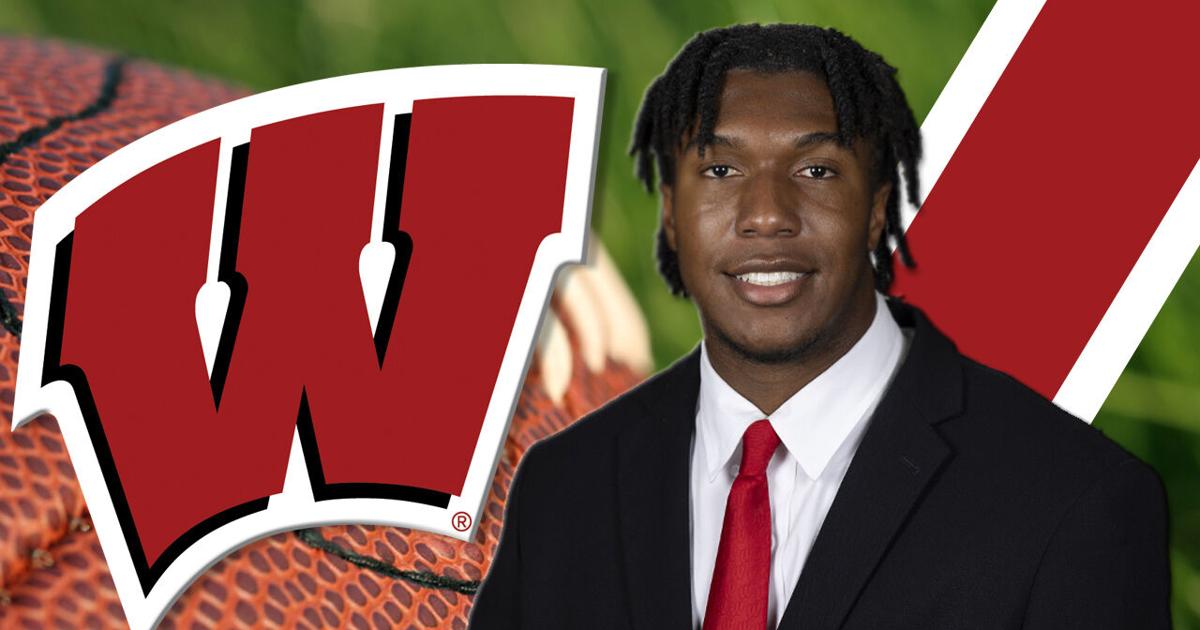
MADISON (WKOW) — UW-Madison is taking legal action after a football player with star potential left the Badgers to play at the University of Miami over the winter. The case could have major implications for how the NCAA handles NIL deals and player transfers.
UW-Madison and VC Connect LLC have filed a lawsuit against the University of Miami, alleging the Hurricanes wrongfully interfered with Name, Image, and Likeness (NIL) contracts. The complaint, filed on Friday, claims Miami induced Xavier Lucas to break his agreements and transfer.
Lucas had signed lucrative NIL contracts with UW-Madison and VC Connect for the 2025 season. However, Miami allegedly tampered with these agreements, causing him to leave Madison and enroll at Miami, violating NCAA anti-tampering rules.
The up and coming cornerback entered the transfer portal in December 2024. He was coming off a freshman season where he played 11 games, recording 18 tackles and grabbing an interception.
Lucas was a four-star prospect coming out of high school. He was born in Pompano Beach, Florida, about an hour north of Miami.
The complaint outlines how Miami’s actions resulted in significant financial and reputational harm to the plaintiffs. It also highlights the broader implications for college athletics, emphasizing the need to protect contractual commitments amid the evolving NIL landscape.
Miami’s conduct reportedly included contacting Lucas and offering more lucrative financial terms, despite the player’s existing commitments. UW-Madison and VC Connect seek damages and a declaration that Miami’s actions constituted tampering.
The University of Miami has not yet responded to the allegations.
NIL
Wisconsin Sues Miami over NIL Deal
In January, a Wisconsin player (Xavier Lucas) signed in NIL deal and then left to go to Miami – outside of the transfer portal. Wisconsin is alleging that Miami interfered with a binding contract. No idea if this will be successful. But, it calls the question on whether NIL deals are enforceable against players. If […]

In January, a Wisconsin player (Xavier Lucas) signed in NIL deal and then left to go to Miami – outside of the transfer portal. Wisconsin is alleging that Miami interfered with a binding contract.
No idea if this will be successful. But, it calls the question on whether NIL deals are enforceable against players. If they aren’t, then it is hard to imagine what rights schools actually have. Players can theoretically just leave any time they feel like it if someone else offers more money.
https://www.espn.com/college-football/story/_/id/45552578/wisconsin-sues…
NIL
What’s new with the Arizona Men’s Basketball 2025-26 roster
TUCSON, Ariz. — During the off season, Arizona Men’s Basketball got busy. Head Coach Tommy Lloyd and his staff landing the fourth best recruiting class in the country, all while entering a new era of college athletics. “It’s college basketball,” Lloyd said. “There’s a lot of moving parts in an off season now. You talk […]
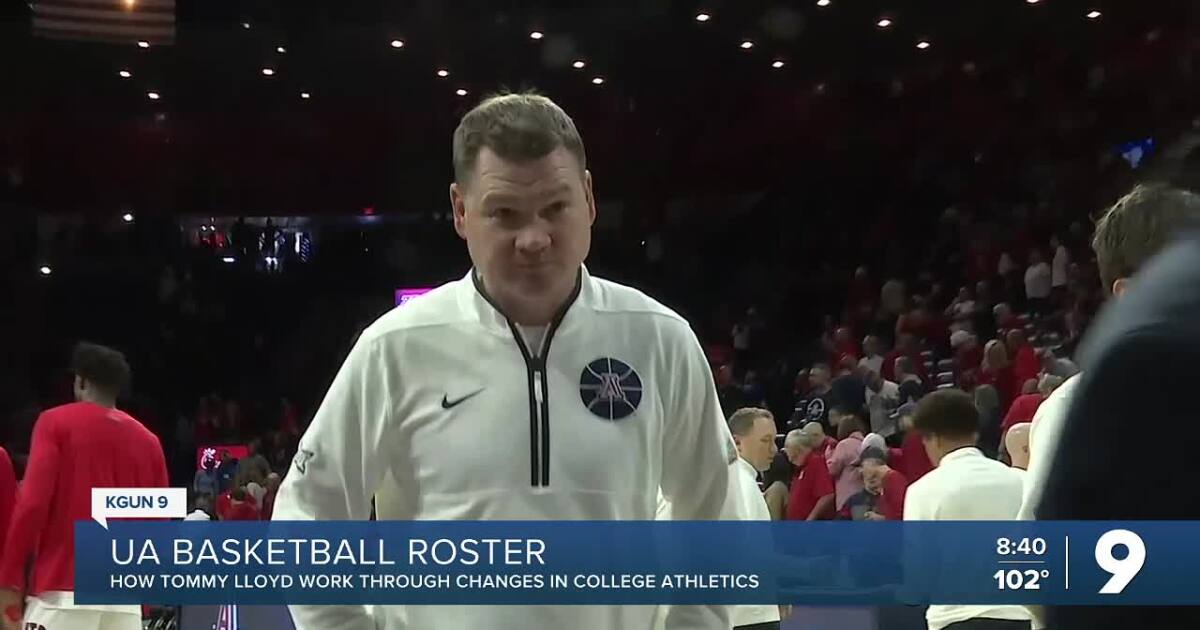
TUCSON, Ariz. — During the off season, Arizona Men’s Basketball got busy. Head Coach Tommy Lloyd and his staff landing the fourth best recruiting class in the country, all while entering a new era of college athletics.
“It’s college basketball,” Lloyd said. “There’s a lot of moving parts in an off season now. You talk about transfer portal, NIL, the house settlement but you work yourself through it and you’re trying to do the best job to set your next team up for success.”
While the Wildcats will have multiple returning players, the program will be seeing many new, and young, faces for the 2025–2026 season.
“At some point you got to recruit some younger players and the one thing we did know going into this season was that this was going to be the fifth season post COVID,” Lloyd said. “We knew those kids that were granted that automatic waiver for the extra year of eligibility, that was going to dry up.”
Along with four returning players, Jaden Bradley, Anthony Dell’Orso, Tobe Awaka and Motiejus Krivas, the Wildcats bring in seven new players, six of them being freshman.
Joining Arizona are three 5-Star recruits, Dwayne Aristode, Brayden Burries and Koa Peat. Two international players, Mabil Mawut and Sidi Gueye. A transfer from Harvard, Evan Nelson, and rounding out the additions, 3-Star recruit, Bryce James.
Even in the changing landscape of college athletics while recruiting Lebron James’s son, Lloyd had no hesitations when it came to Bryce.
“Sometimes I think it’s unfair to a kid like Bryce,” Lloyd said. “Their are people kind of making decisions on his future. Not his family’s future, Bryce’s future, just based on who his parents are. He’s a 17-year-old kid, he’s just moved away from home and he’s running his own race. Let’s give him some space and let him develop into his own man.”
Lloyd and his staff building this roster in the heat of NIL and the NCAA house settlement that will now allow schools to pay it’s players directly.
“I’m a coach,” Lloyd said. “I’m somebody who, you let me know what the rules are, and I’m going to figure out how to work with the rules to make our program successful.”
Arizona Athletics announced its five-year plan, the Bear Down Blueprint, hoping to give direction when the house settlement is implemented.
“That’s all I care about,” Lloyd said. “My team is judged on our performance and so I have to focus on how to make our team perform better. We have a staff that’s a lot smarter than me within this athletic department at figuring that stuff out and I’m just going to follow their lead.”
——
Erin Patterson is a reporter for KGUN 9. She’s agraduate of the University of Alabama with a Bachelor’s in News Media with a Sports Concentration. Erin recently obtained her Master’s Degree in Sports Journalism from Arizona State University at the Walter Cronkite School of Journalism, where she gained experience a sports reporter, anchor and producer. Share your story ideas and important issues with Erin by emailing erin.patterson@kgun9.com.

—-
STAY IN TOUCH WITH US ANYTIME, ANYWHERE
NIL
Cache AI enters NIL arena at Section 7 to evaluate athlete potential
Vail’s Cienega High School defeats Tempe’s McClintock to earn one of six qualifying spots for the Section 7 boys basketball tournament at Arizona Athletic Grounds on June 18, 2025. (Photo by Payne Moses/Cronkite News) Cache AI, an evaluator tool driven by artificial intelligence, gives players a 0-100 rating based on what they offer as an […]
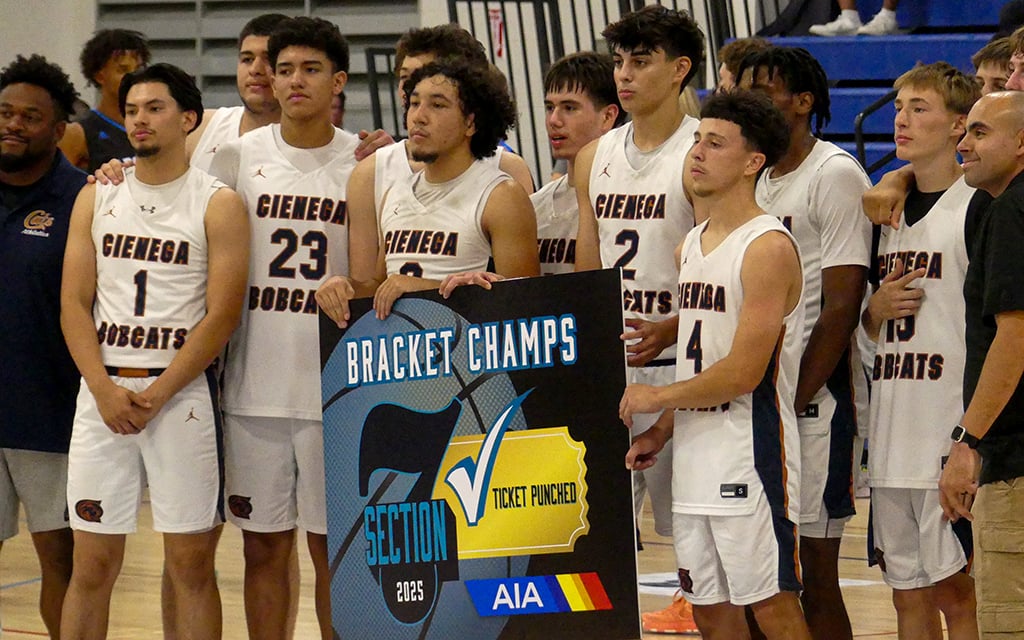

Vail’s Cienega High School defeats Tempe’s McClintock to earn one of six qualifying spots for the Section 7 boys basketball tournament at Arizona Athletic Grounds on June 18, 2025. (Photo by Payne Moses/Cronkite News)

Cache AI, an evaluator tool driven by artificial intelligence, gives players a 0-100 rating based on what they offer as an athlete and person. (Photo by Payne Moses/Cronkite News)

Players on Tucson’s Sahuaro High School’s basketball team watch from the bench against Phoenix’s Arcadia in a Section 7 tournament qualifying game at Arizona Athletic Grounds in Mesa on June 18, 2025. (Photo by Payne Moses/Cronkite News)

Arizona high schools from across the state competed for six spots in the Section 7 boys basketball tournament on 16 different courts at Mesa’s Arizona Athletic Grounds on June 18, 2025. (Photo by Payne Moses/Cronkite News)

Mesa’s Arizona Athletic Grounds is host of the Section 7 high school basketball tournament for the first time this year. (Photo by Payne Moses/Cronkite News)
MESA – Each coach and team has their needs, but in today’s athletic climate of NIL and revenue sharing, it’s hard to tell an athlete’s value.
One startup online platform is hoping to make that confusion a thing of the past.
Cache AI, an athlete evaluation tool powered by artificial intelligence, was launched on June 6 and its first athletes in the system are participants of the Section 7 high school basketball tournament in Mesa. In April, Section 7 announced Cache AI as its presenting partner for 2025.
“Not only can we help (coaches’) players understand their brand as part of their development … we can help with both NIL value and revenue value,” said Kobi Wu, founder and CEO of Cache AI.
Cache AI is designed to help coaches to identify talent in an unbiased way, with nothing to gain and nothing hidden under the table.
All boys and girls were given a CacheScore, which is a 0-100 rating that is optimized by the tool’s AI-infused algorithm and an accompanying athlete profile with their GPA, social media presence, sport skills and more such as community service efforts. Every player entered with a “pre-generated” profile which they can then improve with their personal input, according to Wu.
The 2025 edition of Section 7 – first introduced in 2019 by Matt King, University of Arizona’s president of basketball operations – moved to Mesa following three years at Glendale’s State Farm Stadium.
If 12 simultaneous basketball games wasn’t enough, Arizona Athletic Grounds allows for 16. With 96 Arizona teams battling for tournament entry over just two days, the chaos may be overwhelming for first-timers but it has license to unfold.
What does 8 high school basketball games look like all at once? And sound like?
Here you go.@Section7Az @sportscronkite pic.twitter.com/AEYCcDWSm8
— Payne Moses (@pwmoses11) June 18, 2025
As Section 7 benefits the host venue, hosting partners and the statewide economy, its slogan is undeniably player-first: “Where talent meets opportunity.”
The massive showcase is making efforts to expand its pull even further with the event’s founder, Arizona Basketball Coaches Association, partnering with the Arizona Sports & Entertainment Commission.
Wu said she met up with ASEC executive director Nikki Balich in February to discuss the mutual partnership after Balich expressed her belief in the service over the phone.
“(Balich said) ‘I want to do something great for the kids in the tournament,’” Wu said. “And I said, ‘That’s why we’re here.’ That’s why we exist. … We’re athlete-first. We want the kids to have an understanding of their value always. Things shouldn’t just be put upon them.”
Without the burden of curating their overall value, athletes like Jackson Moore of Vail’s Cienega High School can focus on their play.
In the midst of officials blowing whistles left and right, hundreds of fans roaming about and cheering and basketballs taking liftoff on Wednesday, Moore and Cienega punched one of six tickets into the weekend’s Section 7 tournament at Arizona Athletic Grounds.
“To qualify is amazing because we get to play in front of all (these) college coaches, scouts, everything,” Moore, a rising junior, said. “We’ve been in this environment before. We were able to qualify last year, made it, won a game (after) qualifying last year, so it was an amazing experience.”
.@AZPreps365 Cienega beat McClintock to punch their ticket to the @Section7Az weekend tournament.
The Bobcats also advanced in the 2024 edition but had to win an extra game (4) this time around with a larger field.@sportscronkite pic.twitter.com/tpAVesEcKy
— Payne Moses (@pwmoses11) June 18, 2025
For Nick Springer, a rising senior at Scottsdale’s Chaparral High School, college basketball is a goal of his. And he has the chance to increase his exposure to college-level coaches this weekend with his team defeating 5A rival Desert Mountain to qualify for the tournament. El Mirage’s Dysart, Tucson’s Salpointe, Phoenix’s Arcadia and Peoria’s Centennial rounded out the Arizona qualifiers.
“I’ll see how the year goes, but (college) is definitely an option,” Springer said.
This year, coaches from 261 universities, including Arizona State, Arizona, Grand Canyon and Northern Arizona, will be in attendance, according to Balich. They already witnessed about 2,200 girls play and, once this weekend concludes, about 3,840 boys.
Just because the NCAA sanctions this event, that doesn’t prevent NAIA coaches, especially local ones, from coming out.
Tyler Ojanen, Ottawa University Arizona men’s basketball coach in Surprise, said he will be present for all five competition days. Though he’s “taking it all in,” Ojanen said he is looking to add a point guard for this upcoming season.
Ben Olesen, a second-year assistant for Embry-Riddle Aeronautical University in Prescott, said his team is on the lookout for “bigs” as most of their seven freshmen last season were guard-type players.
In the early years of NIL activation, college programs have witnessed athletes receive money, but money of arbitrary value. As the House v. NCAA case reached an initial settlement on the same day Cache AI launched in Mesa, Wu said she wants to be in on the conversation to aid schools with understanding where NIL funds are streaming from.
Wu added she thought Cache AI’s start would be directed at college athletic directors – with the tool being in direct communication with colleges – and “a few elite high school programs,” but Section 7 came knocking.
Balich said she had conversations about the new tool at a Power Four school three weeks back and the school had a false perception of the service.
“‘(Cache AI) is all biased, right?’ Balich said the school asked her. “Cache AI doesn’t represent any student. They will never represent any athletes. … Cache doesn’t care who picks the students up. They’re just offering the thing. … You know, Kenny (Dillingham) you make the decision.”
The tool has the potential to be a game-changer, according to Balich.
“I know that if people take a look at it and stop thinking that they know everything about AI, and what this could be, dude, this thing’s bomb. This is Nike before Nike,” Balich said.
Besides a free CacheScore, Section 7 participants will have access to the whole tool until a few days after the tournament and the option to continue using it, according to Wu. The key: players aren’t the ones that pay, but rather the schools.
“Players should be able to know how their brand is pacing and they should be able to have control or some transparency in that,” Wu said.
Every player competing in @Section7Az has plenty of food and beverage options at Arizona Athletic Grounds.
And there’s a flaming basketball encouraging fans to check out official event merchandise.@sportscronkite #WhereOpportunityMeetsTalent pic.twitter.com/S70CFdS1on
— Payne Moses (@pwmoses11) June 18, 2025
Beginning Friday, 166 high school teams from the following states will compete for sectional glory: Arizona, California, Utah, Colorado, New Mexico, Nevada, Idaho, Oregon, Washington, Hawaii and Florida.
Teams will win and teams will lose. Individuals will prove their skill and individuals will perhaps have eyeballs on their craft for the first time.
But with the unique opportunity to develop athletic branding, coaches and players may leave Mesa empowered beyond a significant yet fleeting tournament.
Cesar Chavez boys basketball coach Marcus Wright, who played collegiate basketball at Point Park University in Pittsburgh, Pennsylvania, said some of his players are considering the next level but need to “match the work ethic and energy level” required.
This scholastic showcase and new tool are designed to spark those aspirations and, more importantly, shine light on life skills.
“Three pillars we are focusing on beyond the CacheScore and CacheValue is financial literacy, community service leadership and the third is brand and career development,” Wu said.
“(Players) are going to get recruited. Yes, that is the focus,” Wu said. “But it’s also for development.”
NIL
Colorado Buffaloes legend Shedeur Sanders addresses off-field mistakes during Browns charity softball game
It’s not exactly the spotlight Shedeur Sanders had in mind. Just days after being cited for driving 101 mph in a 60 zone—which is apparently his second speeding ticket in less than two weeks—former Colorado Buffaloes quarterback Shedeur Sanders finally broke his silence. But it didn’t come in a press conference or through a team-issued […]
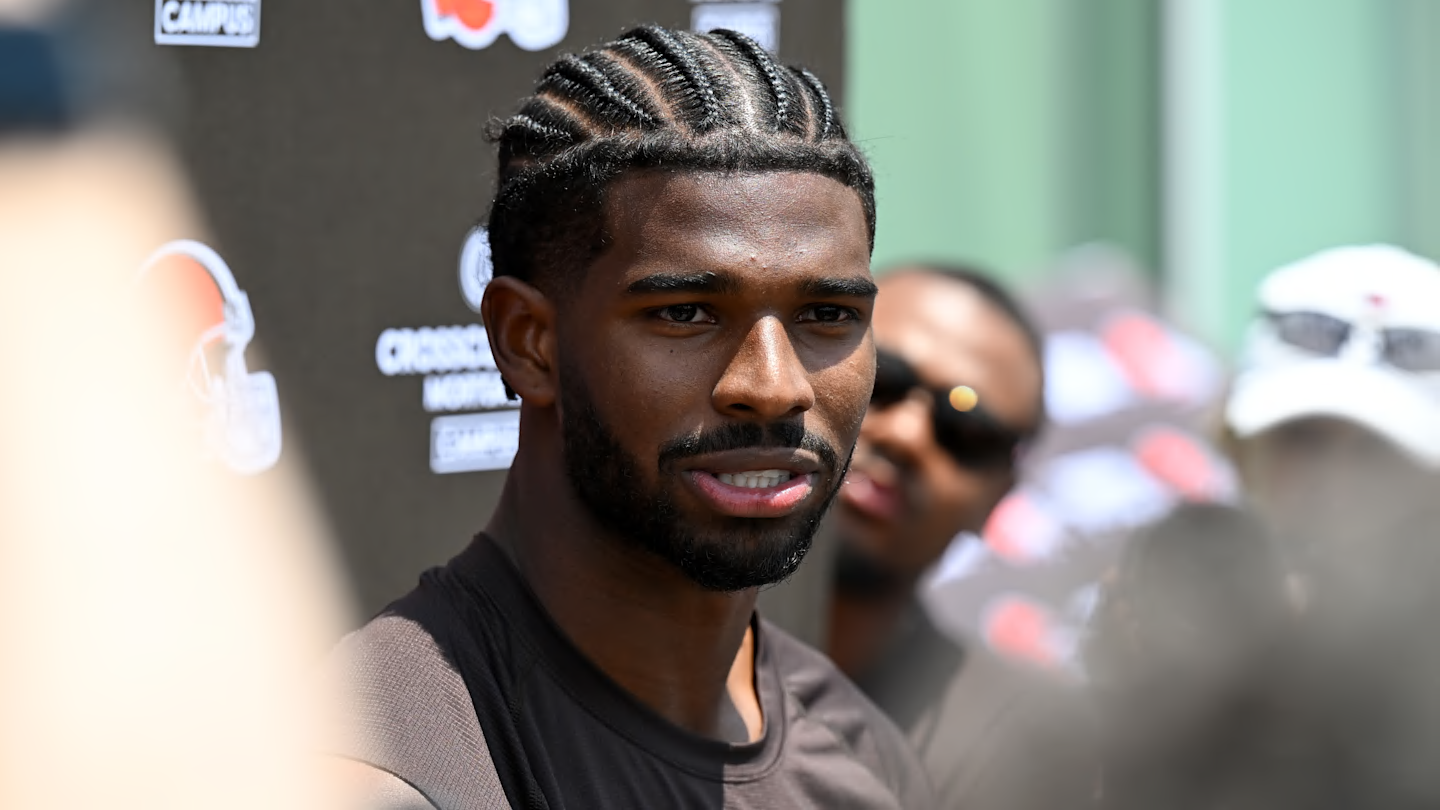
It’s not exactly the spotlight Shedeur Sanders had in mind.
Just days after being cited for driving 101 mph in a 60 zone—which is apparently his second speeding ticket in less than two weeks—former Colorado Buffaloes quarterback Shedeur Sanders finally broke his silence.
But it didn’t come in a press conference or through a team-issued statement. It came in a softball dugout.
At David Njoku’s Celebrity Softball Game in Eastlake, Ohio, Sanders turned a lighthearted exchange with rapper Doe Boy into something deeper.
“I’ve made some wrong choices,” Sanders said, smiling, but not ducking. “I can own up to it. I learn from them.”
Shedeur Sanders said this about his speeding violation:
“I’ve made some wrong choices, I can own up to it—I learn from them”
pic.twitter.com/RUTa1IJ20f
— GUCCE
(@gucceCU) June 19, 2025
It was a shift in tone—something that felt needed after a rough couple of weeks for Sanders’ image.
Because let’s not sugarcoat it: this isn’t a good look.
Sanders is in the middle of a three-way quarterback competition in Cleveland. He’s a fifth-round pick trying to earn a spot in a room that already includes Joe Flacco, Kenny Pickett, and fellow rookie Dillon Gabriel.
Every rep matters. Every impression matters.
And now, instead of the media focusing on whether Shedeur’s talent will translate to Sundays, the conversation has veered off the road entirely—literally.
More details have been coming out due to court records becoming public. He’s had, not one, but two speeding tickets, and even worse, he missed a court date for one of them. His first ticket, 91 mph in a 65, came on the final day of Browns OTAs. The second, 101 in a 60, happened during rookie orientation.
That kind of pattern raises questions, not just about maturity, but about commitment—fair or not.
As someone who just this week defended Sanders against early OTA overreactions, this is frustrating.
I wrote that we shouldn’t read too much into June minicamp reps. That it was far too early to crown Dillon Gabriel or count out Shedeur Sanders.
But you can’t afford two high-speed citations and off-the-field distractions when you’re still earning a spot.
To Shedeur’s credit, he seems to understand that. And you could see it on his face during the softball game. The smile was there, sure. But so is the weight. This was a young quarterback trying to own it and move forward.
And to be fair, it wasn’t all bad news in Ohio.
Sanders was swarmed by fans, including one young voice yelling, “You’re QB1! Nobody else but you!” Sanders smiled and replied, “I need him to be my motivator.” He laughed, signed autographs, and even knocked in an RBI double—showing off a bit of the two-sport DNA he inherited from his Hall of Fame father.
Shedeur Sanders looking like Pop’s

#NFL #dawgpound #SkoBuffs
pic.twitter.com/SbHr4nA4Rr— Ossacin’s Ducktail (@OssacinDucktail) June 20, 2025
This is still the same Shedeur Buffs fans remember. The young man who made Colorado football matter again.
But if he wants to win over Cleveland—and win this quarterback battle—he has to prove more than just talent. He has to prove he can be trusted.
Right now, the Browns are saying very little publicly. According to reports, they expect Sanders to “take care of” the tickets. But there’s no doubt the coaching staff is watching closely.
They have to. In the NFL, your off-field decisions matter just as much as your arm strength, availability and accountability.
There’s still time for Shedeur to right the ship. Rookies report to training camp on July 18. Between now and then, Sanders has to show growth—off the field, in the playbook, and in his daily discipline.
One quote won’t erase his two speeding tickets. But maybe, just maybe, it’s the start of a better chapter.
— Want more stories like this? Follow us on X for all things Colorado Football and Basketball.
NIL
Wisconsin suit against Miami alleges tampering with Xavier Lucas
Jeremiah Smith, Ryan Williams on cover of EA Sports College Football ’26 EA Sports chose Ohio State’s Jeremiah Smith and Alabama’s Ryan Williams to be on the cover of College Football ’26. We talk to the athletes about what this moment means to them. The latest first has come to the current era of college […]
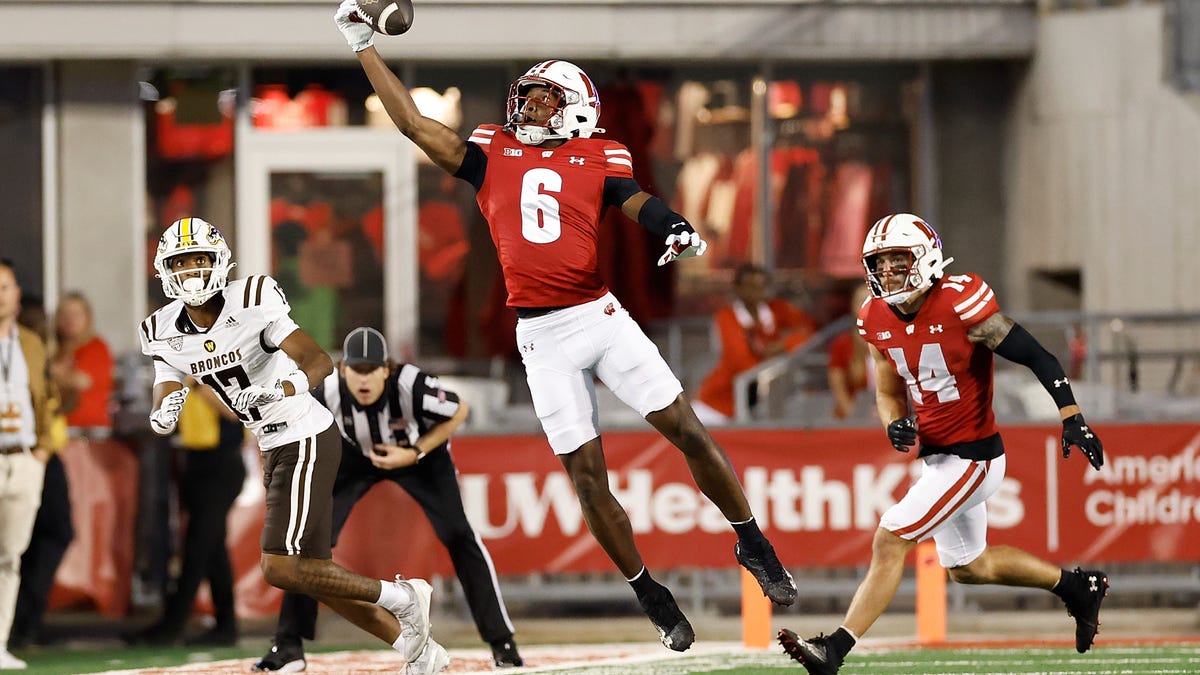
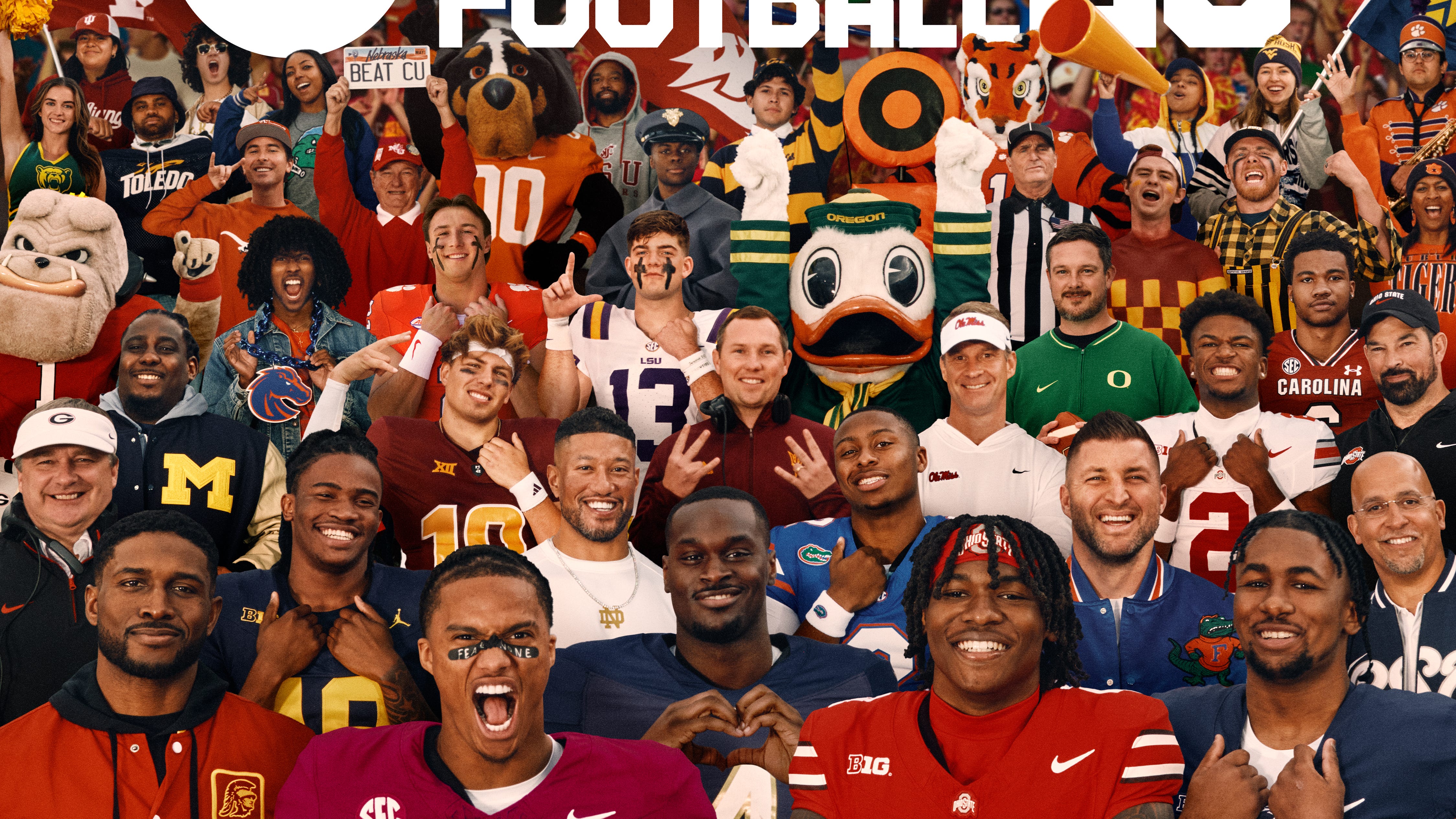
Jeremiah Smith, Ryan Williams on cover of EA Sports College Football ’26
EA Sports chose Ohio State’s Jeremiah Smith and Alabama’s Ryan Williams to be on the cover of College Football ’26. We talk to the athletes about what this moment means to them.
The latest first has come to the current era of college football, with name, image and likeness (NIL) reigning supreme.
Wisconsin football and its NIL collective filed a complaint in state court on June 20 against Miami over alleged recruiting interference, according to a report from Yahoo Sports’ Ross Dellenger. The move is the first of its kind and a potentially precedent-setting action.
The situation revolves around former Wisconsin defensive back Xavier Lucas, with the school claiming that Miami interfered with Lucas’ revenue-binding contract with the Badgers and their NIL collective. Lucas left Wisconsin for Miami in January.
Lucas notably transferred to Miami without entering his name in the transfer portal, according to numerous reports in January. Lucas had announced his intention to enter the portal in December, but Wisconsin reportedly refused to put his name in the portal after he had already signed a contract with the school.
The documents obtained by Yahoo Sports claims Miami communicated with Lucas despite knowing the defensive back had already signed a contract with Wisconsin.
“Miami interfered with UW-Madison’s relationship with Student-Athlete A (Lucas) by making impermissible contact with him and engaging in tampering,” the suit writes, according to Yahoo Sports
“We stand by our position that respecting and enforcing contractual obligations is essential to maintaining a level playing field,” Wisconsin said in a statement to Yahoo Sports. “In addition to our legal action, we will continue to be proactive to protect the interests of our student-athletes, our program and the broader collegiate athletics community.”
Dellenger also reported the Big Ten support Wisconsin on the matter.
Revenue sharing was approved in a House settlement on June 6, allowing for schools to directly pay athletes across all sports. The Wisconsin-Miami case could serve precedent for future situations of alleged or potential tampering.
Lucas finished his freshman season at Wisconsin with 18 total tackles, a sack and an interception. The 6-foot-2 defensive back from Pompano Beach, Florida, withdrew from classes at Wisconsin and enrolled at Miami as a student in order to skirt the NCAA transfer rules regarding enter your name in the transfer portal during the two separate portal windows.
Lucas reportedly signed a two-year revenue sharing contract with Wisconsin, according to Yahoo Sports. The contract binds the player’s non-exclusive rights to the school, allowing it to market their NIL. The contract forbids the player’s NIL rights to be used by other schools.
-

 High School Sports2 weeks ago
High School Sports2 weeks agoParents Speak Out As Trans Pitcher Throws Shutout In MN State Quarterfinals
-

 Professional Sports2 weeks ago
Professional Sports2 weeks ago'I asked Anderson privately'… UFC legend retells secret sparring session between Jon Jones …
-

 Health2 weeks ago
Health2 weeks agoOregon track star wages legal battle against trans athlete policy after medal ceremony protest
-

 Professional Sports2 weeks ago
Professional Sports2 weeks agoUFC 316 star storms out of Media Day when asked about bitter feud with Rampage Jackson
-

 NIL3 weeks ago
NIL3 weeks agoNCAA Sends Clear Message About Athlete Pay and Roster Limits
-

 NIL3 weeks ago
NIL3 weeks agoMen's college basketball Top 25 reset
-

 Social Media3 weeks ago
Social Media3 weeks agoControversial Athletics Gender Dispute Goes Viral After Riley Gaines Lashes Over Authorities
-

 College Sports2 weeks ago
College Sports2 weeks agoOKC’s Mark Daigneault knows what it takes to win championships. His wife has won a ton of them
-

 Rec Sports3 weeks ago
Rec Sports3 weeks ago2x NBA All-Star Reacts to Viral LeBron James Statement
-

 Motorsports1 week ago
Motorsports1 week agoNASCAR Weekend Preview: Autódromo Hermanos Rodríguez








 | WNBA on ESPN
| WNBA on ESPN
























